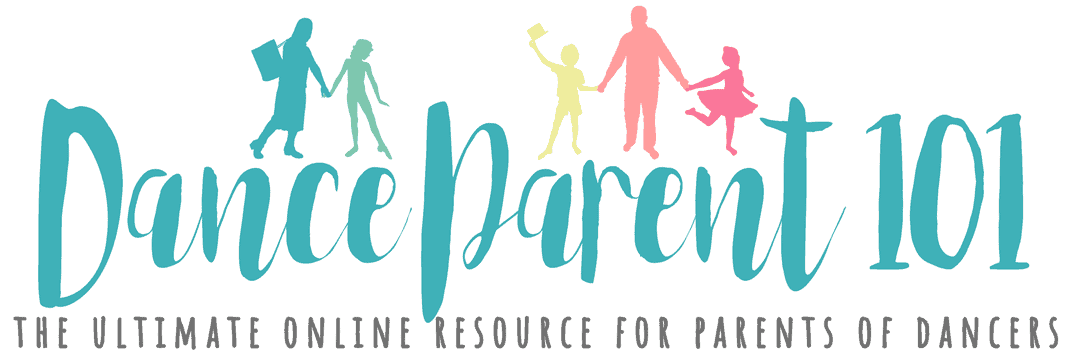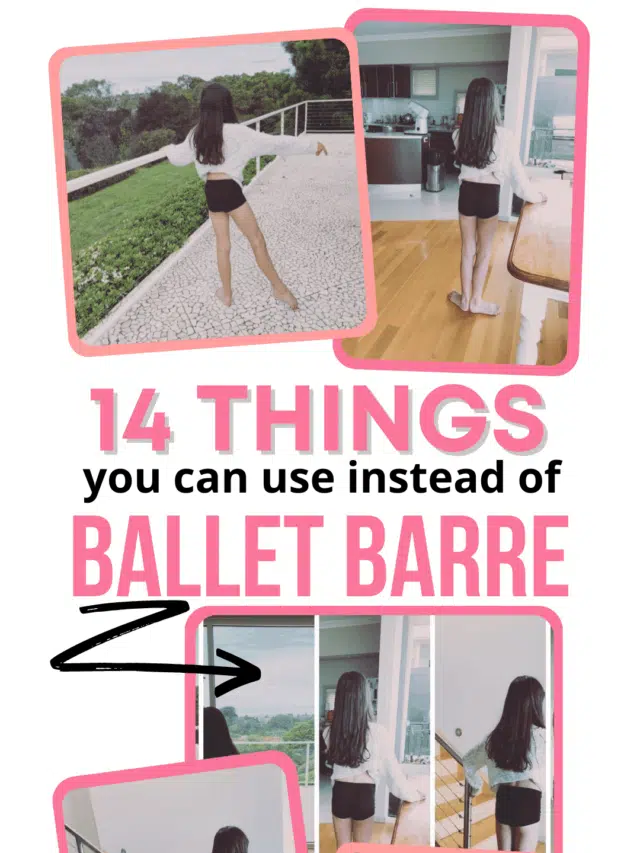When doing ballet or dance away from the studio, the dancer is often left with the conundrum of what they are going to use as a substitute barre. And with more and more people opting to take and try dance lessons at home the question is being asked more and so I thought I would address it as well as give some ideas, tips and tricks for using substitutes to a ballet barre.
Instead of using a ballet barre, a dancer can use a chair or stool, a table, a desk, or even a kitchen bench. A broomstick attached securely between two chairs can create a makeshift barre. A balcony, porch, or pergola railing are also good options.

Ultimately purchasing a portable ballet barre is always going to be your best option and you can read about my best choices for a portable ballet barre here. I actually opted to make a DIY ballet barre from PVC pipe as well as one from galvanized steel for my girls to use at home instead of a chair and you can look at the instructions and video tutorials for those here on the Dance Parent 101 website.
So lets have a quick look at some of your options, there pros and cons so you can work out which will work best for your situation.
- 1. A Chair
- 2. Two Chairs and a Broomstick
- 3. A Bar Stool
- 4. A Table
- 5. A Desk
- 6. A Kitchen Bench
- 7. Inbuilt Cabinetry
- 8. Stair Railings
- 9. Balcony, Porch or Pergola Railing
- 10. A Couch or Sofa
- 11. A Tall Bed End
- 12. A Small Piece of Sturdy Furniture
- 13. DIY PVC Ballet Barre
- 14. DIY Galvanized Steel Ballet Barre
- SPACES AND FURNITURE YOU SHOULD NOT USE AS A SUBSTITUTE BARRE – EVER!
- Check Out Our Google Web Story!
1. A Chair
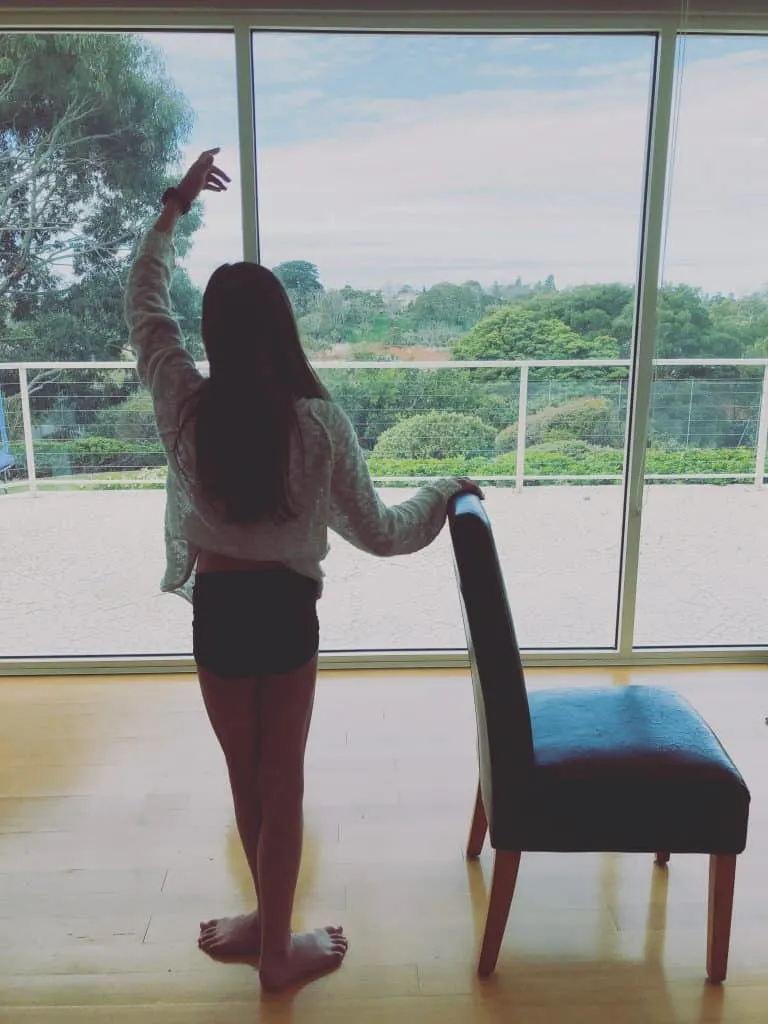
The humble chair is probably your go to piece of furniture when you don’t have access to a barre.
What to look for in your chair:
If you have several chairs to choose from select the heavier and sturdier chair, because you don’t want it to move around as you are doing your exercises. A flat and rounded edge around the top of the backrest of the chair is also good as this is where you are going to rest your hand.
How to use a chair as a ballet barre:
To use a chair as a ballet barre you use the back of the chair and rest your hand on the top of the back rest. This means the back of the chair is facing you – as if you were going to push the chair under the table after sitting on it.
| PROS | CONS |
|---|---|
| Easy to find | Can slide or move easily. |
| Back of the chair is a good height for a ballet barre. | Chair legs can get in the way of your own legs – |
| Portable can be moved easily to suit your location. | Chair can tip towards you. |
| Not long like a barre for stretching |
TOP TIP
Weigh the seat of the chair down to increase the sturdiness – better yet ask someone to sit in the chair as you do your lesson – good luck with that though LOL!
2. Two Chairs and a Broomstick
Create your own make shift barre with a couple of chairs and broomstick, mop or anyother long round stick you have around the house.
How to make your makeshift chair and broomstick barre:
Place your chairs opposite each other, the length of your broomstick. Whether you place them with their seats or backs facing each other or a combination, will depend on your chairs and how you are best able to secure the broom stick to them.
Use tape, rope, string or whatever else you have to secure your broomstick to each chair. (Be mindful that tape when ripped off can ruin the appearance of your chairs and rope if tied too tighlty can create marks)
How to use your chair and broomstick barre:
Stand at the centre of the broomstick, side on and gently place your hand onto the rod. Use a light touch.
| PROS | CONS |
|---|---|
| Easy objects to find around the home. | May ruin your chairs. |
| Back of the chair is a good height for a ballet barre. | Not sturdy – I would not rest your leg onto the barre. |
| Portable can be moved easily to suit your location. | You may need to continually pull this apart if you need the chairs, broomstick, or do not have the space to store your DIY creation. |
| Creates space under the barre for you to use and move your legs like a real ballet barre. |
TOP TIP
Use old chairs or chairs that are rarely used in case you mark them when you secure your stick to them.
3. A Bar Stool
A bar stool with a sturdy backrest is another option to look around for when in need of a ballet barre.
What to look for when using a bar stool as a ballet barre:
Not all stools have backrests, so if your stool does not have a backrest, it won’t be a good substitute for a ballet barre. A stool with a big heavy base is also good as it is less likely to move whilst you do your barre exercises. If your stool is adjustable – up and down – you can also adjust it to be the perfect height. One thing you do not want though is a stool that twists and rotates as many do, although this could add an interesting challenge into your dance workout!
How to use a bar stool as a ballet barre:
To use a stool as a ballet barre you use the back of the stool and rest your hand on the top of the back rest. This means the back of the chair is facing you – as if you were going to push the stool under the bar after sitting on it.
| PROS | CONS |
|---|---|
| Good for taller dancers. | Some rotate and spin which is not ideal for a substitute ballet barre. |
| Portable can be moved easily to suit your location. | Stool legs can get in the way of your own legs. |
| Stool can tip towards you. | |
| Not long like a barre for stretching |
TOP TIP
Weigh the seat of the stool down to increase the sturdiness – better yet ask someone to sit in the stool as you do your barre work – good luck with that though LOL!
4. A Table
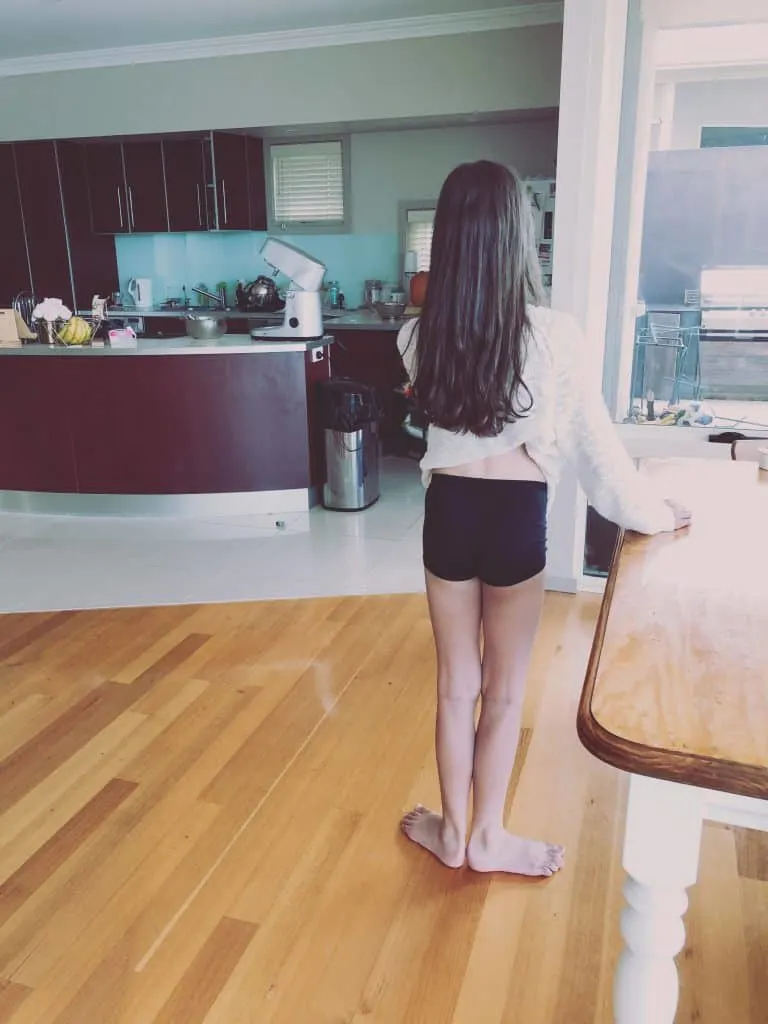
A table is a good option for shorter dancers and children, it is a great way to teach yourself not to grip the barre, as this is hard to do with a table edge.
What to look for when using a table as a ballet barre:
Any kind of table or desk will be fine, but the best to use will have a long sides such as in the shape of a rectangle or oval – a circle shaped table will be the hardest to use for all exercises. I would not recommend using a table or desk with a glass tabletop for safety reasons. A table with the legs far from each other rather than one large stand in the middle is also better as then you can face the table you can tendu or shuffle if tapping forwards without any obstructions.
How to use a table as a ballet barre:
Clear any chairs from under the table on one side. Stand side on and in between the legs of the table rather than close to them and rest your hand on the edge of the table like you would a ballet barre.
| PROS | CONS |
|---|---|
| Sturdy and generally should not move. | A table – such as your dining table is not something you can easily move if needed. |
| Should be able to place a foot on the table to stretch. | Some people may find using a dining table inappropriate as it is where they eat. |
| Promotes use of the surface for balance as you cannot grip the side of the table easily. | Will be too low for some dancers. |
| Cannot wrap hand around the barre – feels awkward to place hand down flat. |
5. A Desk
Similar to a table, a desk can also be a good option, depending on what it is already being used for.
What to look for when using a desk as a ballet barre:
A nice long desk works best as a ballet barre. A small writing desk can work too, but perhaps the desk with the computer set up and monitors should be avoided to ensure you don’t accidentally knock these over! Nor would I recommend using a desk with a glass tabletop for safety reasons. A desk with the legs far from each other rather is also better as then you can face the desk and when you move your legs forward they
How to use a desk as a ballet barre:
Clear any chairs from under the desk and any papers, pencils, and books from on top of the desk. Stand side on and in between the legs of the desk rather than close to them and rest your hand on the edge of the table like you would a ballet barre.
| PROS | CONS |
|---|---|
| Generally sturdy and should not move. | A desk is not something you can easily move therefore there might not be enough space around it to do your exercises. |
| May be able to place a foot on the desk to stretch. | A desk generally has many other objects on it from a computer to papers and books and it may not be possible to clear it of obstructions quickly and easily. |
| Promotes use of the surface for balance as you cannot grip the side of the table easily. | Will be too low for some dancers. |
| Cannot wrap hand around the barre – feels awkward to place hand down flat. |
6. A Kitchen Bench
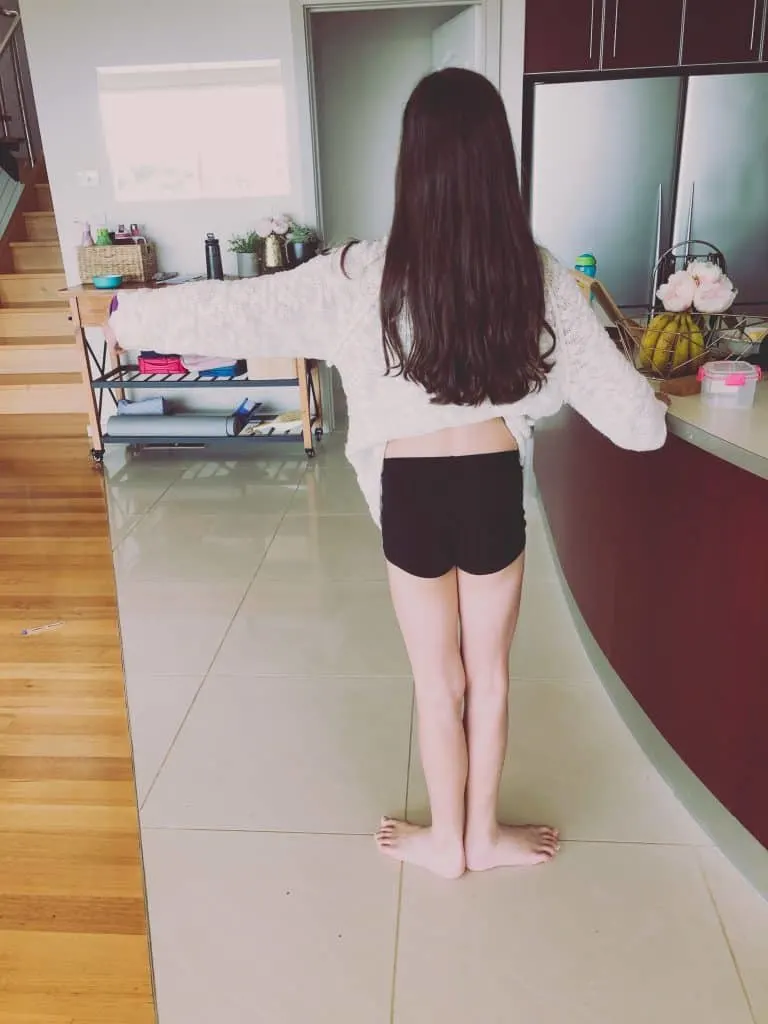
Similar to a table or desk, a kitchen bench can also be a good option to use as a ballet barre as it is super sturdy and long.
What to look for when using a kitchen bench as a ballet barre:
A nice long kitchen bench that has no utilities on it such as a stovetop or kitchen sink – the part usually used for cutting and serving up meals. A kitchen island or a U shaped kitchen usually works best as they generally will have a long free section free of obstructions. You are also looking for free space around the kitchen bench to actually be able to move and do your exercises.
How to use a desk as a ballet barre:
Clear obstructions from the top of the bench and give it a wipe over. Stand side on, in the middle of the longest part of the bench and rest your hand on the edge of the table like you would a ballet barre.
| PROS | CONS |
|---|---|
| Sturdy, will not move. | The kitchen bench is not portable so you will need to do your exercises in the kitchen space. |
| May be able to place a foot on the kitchen bench to stretch. | The kitchen may be used for it’s actual purpose during your lessons and will cause a distraction. |
| Promotes use of the surface for balance as you cannot grip the side of the table easily. | Will be too low for some dancers. |
| Cannot wrap a hand around the barre – feels awkward to place hand down flat. | |
| There may not be adequate space between the top of the bench and the cabinet walls, and a dancer may hit the wall with their foot or toes during their ballet or tap barre work. |
TOP TIP
An overhang such as a breakfast barre is a great part of a kitchen bench to use as the distance between the edge of the bench and the cabinets beneath is wider and you have more room to move your legs and feet.
7. Inbuilt Cabinetry
Inbuilt cabinetry that is secured to the wall will sometimes have a bench or desk like surface built into them that can provide a good ballet barre option.
What to look for when using a kitchen bench as a ballet barre:
A nice long secure shelf (not a floating shelf – one that is actually screwed into the cabinets) or bench that has plenty of space and room around it to move and practice your barre work. If the cabinets are in a quiet or rarely used room this is even better so you are not distracted during your practice.
How to use a desk as a ballet barre:
Clear obstructions from the shelf or bench. Stand side-on, in the middle of the longest part, and rest your hand on the edge of the shelf or table like you would a ballet barre.
| PROS | CONS |
|---|---|
| Sturdy, will not move. | Cabinetry is not portable. |
| May be able to place a foot on the bench to stretch. | Becareful not to use cabinetry that is not secured and screwed as putting pressure on a floating shelf for example may make it fall. |
| Promotes use of the surface for balance as you cannot grip the side of the table easily. | Not the right height for all dancers. |
| Cannot wrap a hand around the barre – feels awkward to place hand down flat. | |
| There will not be adequate space between the surface for resting your hand the cabinetry walls, and a dancer may hit the wall with their foot or toes during their ballet or tap barre work. |
8. Stair Railings
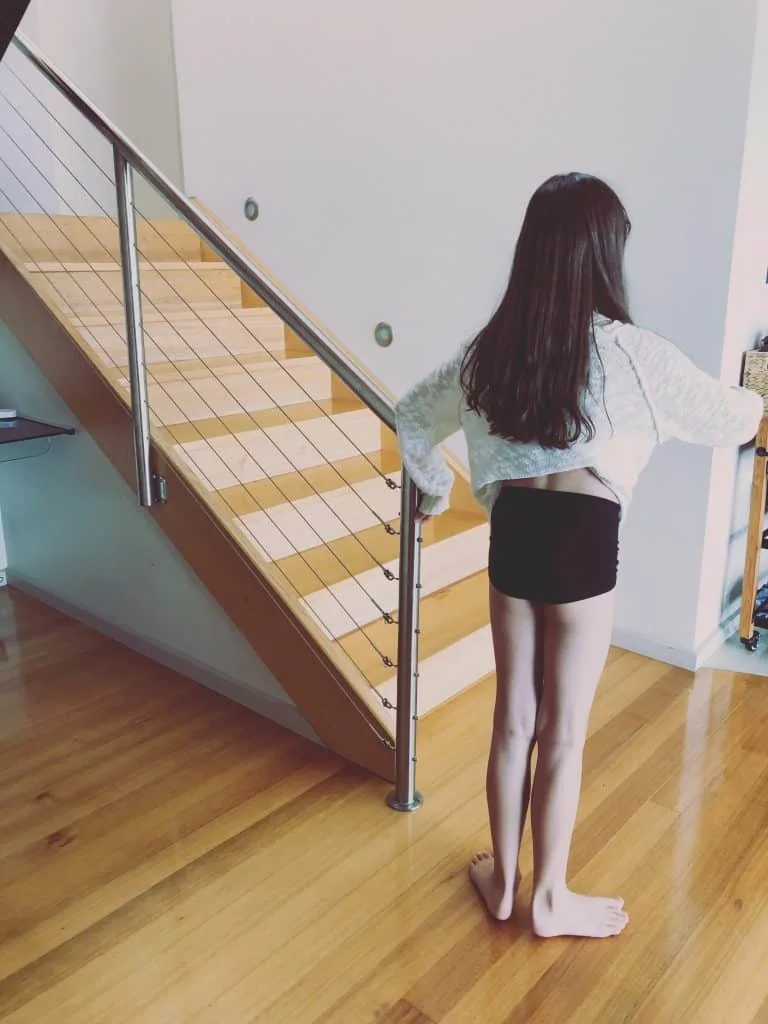
Railings are a great option and substitute ballet barre, as long as the area you use is not where the actual steps are.
What to look for when using a stair railings as a ballet barre:
When you are looking to see if your stair railing can substitute for your ballet barre you need to ensure there is enough flat safe space around your railing to use. I would also NEVER recommend using a stair railing anywhere near an opening to your stairs going downwards as it is all too easy to become unaware of your space, or trip and then fall down the stairs.
How to use a stair railing as a ballet barre:
Stand side-on to the railing and rest your hand on the edge of railing just like you would a ballet barre.
| PROS | CONS |
|---|---|
| Sturdy, will not move. | Railings are not portable. |
| May be able to place a foot on the railing to stretch. | May not be your safest option depending if the longest freest part of your railing is near the opening to the stairway going down. |
| The railing will generally be curved or rounded similar to a ballet barre, providing a similar balance and support. | A stair railing has support beams or additional railings along their side for safety and is not open under the railing like a ballet barre and you are likely to hit them with your feet or toes. |
9. Balcony, Porch or Pergola Railing

Railings are a great option and substitute ballet barre, but these particular railings are generally found outside – so you need to be willing to do your practice out in the fresh air.
What to look for when using a stair railings as a ballet barre:
The first thing you need to ensure is that the railing is smooth and that you are not going to injure yourself using it. If it is metal there should be not rust and if it is wooden, there should be no chance of getting a splinter. The second thing is to make sure the flooring is even and flat. Outdoor spaces may have uneven tiling, slate or wooden planks, so ensure the flooring is safe and adequate before choosing this area to dance on.
Also ensure that you will not be dancing near the opening of some stairs leading downwards such as on a front porch of a house or if on a balcony ensure the railing is secure and never lean over unsafely, or use it in a way that could cause you to fall.
How to use a stair railing as a ballet barre:
Stand side-on to the railing and rest your hand on the edge of railing just like you would a ballet barre.
| PROS | CONS |
|---|---|
| Sturdy, will not move. | Railings are not portable. |
| May be able to place a foot on the railing to stretch. | Depending on it’s location, may not be your safest option for both falling and for the flooring. |
| The railing will generally be curved or rounded similar to a ballet barre, providing a similar balance and support. | A stair railing has support beams or additional railings along their side for safety and is not open under the railing like a ballet barre and you are likely to hit them with your feet or toes. |
| Are generally outside so you could be dancing public and may not be the best conditions depending on the weather. |
TOP TIP
Outside flooring is going to be alot more unforgiving then indoor. Your pergola or porch might include a wood patio, which can easily splinter so think about laying down a dance mat or length of Marley. If the flooring is concrete, opt not to use the area as concrete has no shock absorption and you can injure yourself easily on unforgiving surfaces.
10. A Couch or Sofa
The back of a couch or sofa could be used for balance during dance practice at home.
What to look for when using a couch or sofa as a ballet barre:
First of all, you want your couch or sofa to not be placed against a wall, you need a wide-open space behind the furniture to dance. Secondly, it is better if the back of the couch or sofa is long and straight rather than arched or curved. You will also be wanting to hold onto the sturdier frame of the couch, so if yours is too soft and pillowy around the edges it can still be used but may be slightly more difficult as your hand may move up and down with the sponginess of the cushioning.
How to use a couch or sofa as a ballet barre:
Stand behind the couch or sofa, along the back rest. Stand side-on and rest your hand on the topmost edge just like you would a ballet barre.
| PROS | CONS |
|---|---|
| Will be sturdy and not move. | Your couch may rest against the wall and it may not be convenient to move – plus it will probably be too heavy to do this. |
| May be able to place a foot on the back of the couch to stretch. | If the couch is too soft, it may be spongy and not provide the sturdy surface you need. |
| The height of the back rest of your couch may not be the best height for you. | |
| You may hit your feet on the bottom of the couch as there is no distance between where your hand is and the wall like when using an actual ballet barre. |
11. A Tall Bed End
Some beds come with a tall bed head as well as a bed end. This space at the end of the bed might be perfect especially for a child. Or do you have a poster bed with poles that you could use to balance yourself?
What to look for when using a bed end as a ballet barre:
A long tall bed end, made from a sturdy material such as metal or wood, without ornate decorations. If your bedhead is tall with a nice flat surface to place your hand onto and is not against a wall you could easily use this – but most peoples beds are pushed against a wall.
You are also looking for space around the bed end. If your bed end is right where the door opens or is also up against a second wall, you may not have the space to adequately use this area for dance practice.
How to use a bed end as a ballet barre:
Stand side-on, towards the centre of the bed end, and gently rest your hand on the bed end.
| PROS | CONS |
|---|---|
| Will be sturdy and not move. | Not all beds have a bed end. |
| May be able to place a foot on the bed end or the bed to stretch. | May not be tall enough for all dancers. |
| There is a chance of hitting your leg or toes on the bed frame. |
TOP TIP
Lift up all bedding so you can see the frame of the bed so that you don’t accidentally hit it with your leg or foot.
12. A Small Piece of Sturdy Furniture
Small pieces of sturdy furniture can often substitute as a ballet barre, you just need to look at what you have in your house in a different way!
What to look for when using random furniture as a ballet barre:
Go for a walk around the space you are using or where you live. Do you have a small sturdy piece of furniture such as a shelving or display unit? I found a small set of shelves that could easily be used as a substitute barre, once I actually set my mind to seeing everything in the house being used for the purpose. Suddenly shelving I bought to display my kids toys, looked like a great portable barre alternative. Take a walk around your house and see what objects miraculously turn themselves into a ballet barre for you!
How to use random furniture as a ballet barre:
Stand side-on to the furniture in a way that makes the most sense and rest your hand on the topmost edge just like you would a ballet barre.
| PROS | CONS |
|---|---|
| May be portable. | You may need to take off the objects and things that are on it, for it’s original use each time. |
| The convenience of finding something in your own home or space. | It may not be the perfect height, or have the best space for you to put your hand, or have enough space for you to move your feet. |
TOP TIP
Use your imagination, it might be amazing what everyday piece of furniture or object you could convert into your ballet barre!
13. DIY PVC Ballet Barre
PVC pipe is cheap and when you have the right directions and materials you can easily build a sturdy ballet barre in less than 30minutes!
How to make a DIY PVC Ballet Barre:
Check out these directions and video tutorial on our website here:
Or head to the DIY Ballet Barre homepage by clicking here for step by step instructions, video tutorials, material and tool lists and more!
How to use DIY PVC Ballet Barre:
You can use a DIY PVC Ballet Barre just like you would a normal portable ballet barre.
| PROS | CONS |
|---|---|
| Can be used just like a regular ballet barre. | You need to buy the materials and actually build it. |
| Is portable can be moved around your space. | Lighter than a real ballet barre, and can move easily. |
| Better than using furniture not made to be a ballet barre. |
TOP TIP
If you choose to glue yours together with PVC cement, it will be extremely sturdy, and although lighter than a ballet barre used in a dance studio, can be used in the same way – but just with a lighter touch so that it does not move.
14. DIY Galvanized Steel Ballet Barre
Galvanized Steel pipes comes in set lengths at your hardware store, with threading on the end so you can easily build a sturdy ballet barre with no tolls in less than 30minutes!
How to make a DIY Galvanized Steel Ballet Barre:
Check out these directions and video tutorial on our website here:
Or head to the DIY Ballet Barre homepage by clicking here for step by step instructions, video tutorials, material and tool lists and more!
How to use a DIY Galvanized Steel Ballet Barre:
You can use a DIY Galvanized Steel Ballet Barre just like you would a normal portable ballet barre.
| PROS | CONS |
|---|---|
| Can be used just like a regular ballet barre. | You need to buy the materials and actually build it. |
| Is portable can be moved around your space. | Galvanized metal pipes that are the same thickness as an actual ballet barre are heavy and expensive to buy and so your barre diametre or width will be smaller or thinner than a normal ballet barre. |
| Better than using furniture not made to be a ballet barre. |
TOP TIP
Paint your galvanized steel barre with spray paint for metal for a sleek look and feel to your finished barre.
SPACES AND FURNITURE YOU SHOULD NOT USE AS A SUBSTITUTE BARRE – EVER!
There are several spaces and pieces of furniture I would not recommend using as a substitute barre and this mostly comes down to safety.
- Anything made of glass or similar.
- A towel rail in a bathroom.
- A bathroom.
- Concrete flooring (no shock absorption)
- Tiled or a similar flooring (slippery and no shock absorption)
- In a garage (unless you have created a safe space with dance flooring)
- Any area or surface near a stairwell going downwards.
- An area with uneven flooring.
- Any surface that is rusted or could give you a splinter
